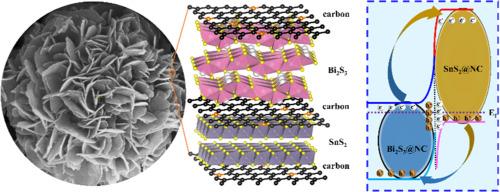Mixed-dimensional van der Waals heterostructure of Bi2S3 nanorods and SnS2 nanosheets bridged with N-doped carbon interlayer for enhanced sodium-ion batteries
IF 18.9
1区 材料科学
Q1 CHEMISTRY, PHYSICAL
引用次数: 0
Abstract
Heterostructure engineering offers significant potential to advance the energy storage capabilities of sodium-ion batteries (SIBs). The typical presence of rich surface states in nanosemiconductors, however, introduces substantial surface barriers that impede surface conductivity, thereby limiting the performance of batteries. Herein, we developed a mix-dimensional van der Waals heterostructure (Bi2S3@NC/SnS2@NC) by synthesizing p-type SnS2 nanosheets on n-type Bi2S3 nanorods, bridged with an ultrathin nitrogen-doped carbon (NC) layer. This structure served as an anode, improving electrochemical performance through additional redox reaction sites and a porous structure that supports electrolyte flow and Na+ transport. This reduces mechanical stress during charging cycles, maintaining structural integrity. Most critically, theoretical and experimental analyses show that the NC layer passivates interface states, enhancing the built-in electrical field and reducing electron and Na+ transport resistance, thereby boosting redox activity. Consequently, the Bi2S3@NC/SnS2@NC anode exhibits a high specific capacity of 290 mAh g−1 after 1400 cycles at 5 A g−1, and 233.6 mAh g−1 at a high rate of 10 A g−1. In full-cell setups with Na3V2(PO4)3 cathodes, it can maintain 461.4 mAh g−1 after 100 cycles at 0.1 A g−1. This work demonstrates the crucial role of heterostructure engineering in advancing efficient energy storage solutions.


用掺杂 N 的碳中间层桥接 Bi2S3 纳米棒和 SnS2 纳米片的混维范德华异质结构,用于增强型钠离子电池
异质结构工程为提高钠离子电池(SIB)的储能能力提供了巨大潜力。然而,纳米半导体中通常存在丰富的表面态,这会引入大量的表面障碍,阻碍表面导电性,从而限制电池的性能。在此,我们在 n 型 Bi2S3 纳米棒上合成了 p 型 SnS2 纳米片,并用超薄掺氮碳(NC)层桥接,从而开发出一种混合维范德华异质结构(Bi2S3@NC/SnS2@NC)。这种结构可用作阳极,通过额外的氧化还原反应位点和支持电解质流动和 Na+ 传输的多孔结构提高电化学性能。这减少了充电周期中的机械应力,保持了结构的完整性。最重要的是,理论和实验分析表明,NC 层可钝化界面态,增强内置电场,降低电子和 Na+ 传输阻力,从而提高氧化还原活性。因此,Bi2S3@NC/SnS2@NC 阳极在 5 A g-1 条件下循环 1400 次后显示出 290 mAh g-1 的高比容量,在 10 A g-1 的高速率条件下显示出 233.6 mAh g-1 的比容量。在使用 Na3V2(PO4)3 阴极的全电池设置中,它能在 0.1 A g-1 下循环 100 次后保持 461.4 mAh g-1。这项工作证明了异质结构工程在推进高效储能解决方案中的关键作用。
本文章由计算机程序翻译,如有差异,请以英文原文为准。
求助全文
约1分钟内获得全文
求助全文
来源期刊

Energy Storage Materials
Materials Science-General Materials Science
CiteScore
33.00
自引率
5.90%
发文量
652
审稿时长
27 days
期刊介绍:
Energy Storage Materials is a global interdisciplinary journal dedicated to sharing scientific and technological advancements in materials and devices for advanced energy storage and related energy conversion, such as in metal-O2 batteries. The journal features comprehensive research articles, including full papers and short communications, as well as authoritative feature articles and reviews by leading experts in the field.
Energy Storage Materials covers a wide range of topics, including the synthesis, fabrication, structure, properties, performance, and technological applications of energy storage materials. Additionally, the journal explores strategies, policies, and developments in the field of energy storage materials and devices for sustainable energy.
Published papers are selected based on their scientific and technological significance, their ability to provide valuable new knowledge, and their relevance to the international research community.
 求助内容:
求助内容: 应助结果提醒方式:
应助结果提醒方式:


